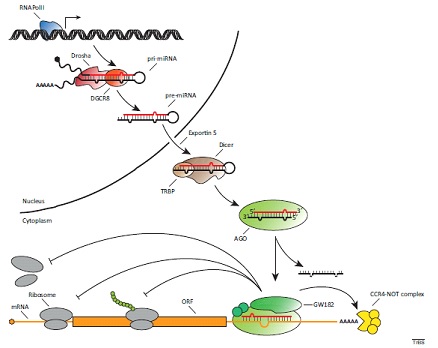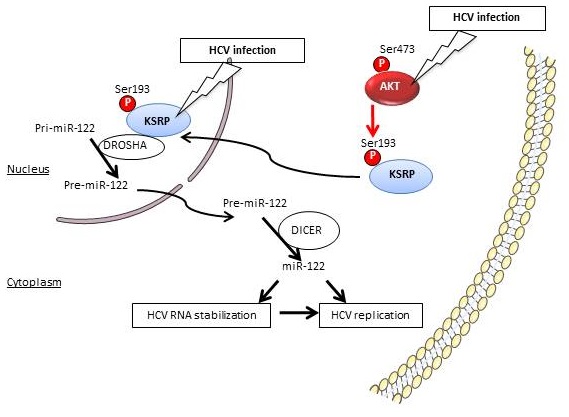

PhD, MCU,
patrice.bruscella@inserm.fr
MicroRNAs (miRNAs) are small non-coding RNAs of approximately 22 nucleotides (nt) involved in the post-transcriptional regulation of many cellular functions.
Mode of action of miRNAs
Genes can encode a single miRNA or clusters from a common primary transcript, pri-miRNA. The pri-miRNAs are transformed by the nuclear RNAse III DROSHA into an intermediate precursor of approximately 70 nt, the pre-miRNA. The pre-miRNA is then cleaved by the cytoplasmic RNAse III DICER to generate mature miRNAs of 22 nt.
Mature miRNAs are associated with a protein complex consisting of Argonaut proteins to form the miRNA-induced silencing complex (miRISC). One strand of the miRNA guides the miRISC complex by interacting with a sequence of 6-8 nt on a mRNA (seed region), causing degradation of the mRNA or stopping its translation.

Maturation of miRNAs and role in post-transcriptional regulation of mRNAs
The activity of miRNAs depends on their association with target RNAs, which may be viral RNAs.
This occurs for HCV, for which the interaction of the genome with the hepatocyte miR-122 is essential for the stability and replication of the viral RNA. Recently, our group has shown that HCV can regulate the processing of proviral miR-122 by modulating the function of KSRP, a cellular protein essential for the maturation of a class of miRNAs.
Maturation of miR-122 and HCV
Post-translational modification of KSRP by the cellular kinase AKT is essential for the maturation of pri-miR-122 to mature miR-122. AKT activity is elevated in HCV-infected cells, resulting in an increase in phospho-KSRP and miR-122 maturation.

HCV regulates its replication by maturing miR-122 via AKT-dependent phophorylation of KSRP
We are currently exploring the ability of other RNA viruses to utilize KSRP to alter intracellular RNA metabolism, including miRNA processing, to promote an infection-friendly environment.
Innovative technologies developed in the laboratory allow us to locate the phosphorylated forms of KSRP in cellulo, follow their direct interaction with cellular or viral RNAs, identify the miRNAs involved, and study their interaction with the target.
Viruses and miRNAs: More Friends than Foes.
Front Microbiol. 2017
Low cross-neutralization of hepatitis C correlates with liver disease in immunocompromized patients.
AIDS 2015
New hepatitis C therapies: the toolbox, strategies, and challenges.
Gastroenterology 2014
Human hepatic stellate cells are not permissive for hepatitis C virus entry and replication.
Gut 2015
Genome-wide analysis of host mRNA translation during hepatitis C virus infection.
J Virol. 2013
Occult infection of peripheral B cells by hepatitis C variants which have low translational efficiency in cultured hepatocytes.
Gut 2010